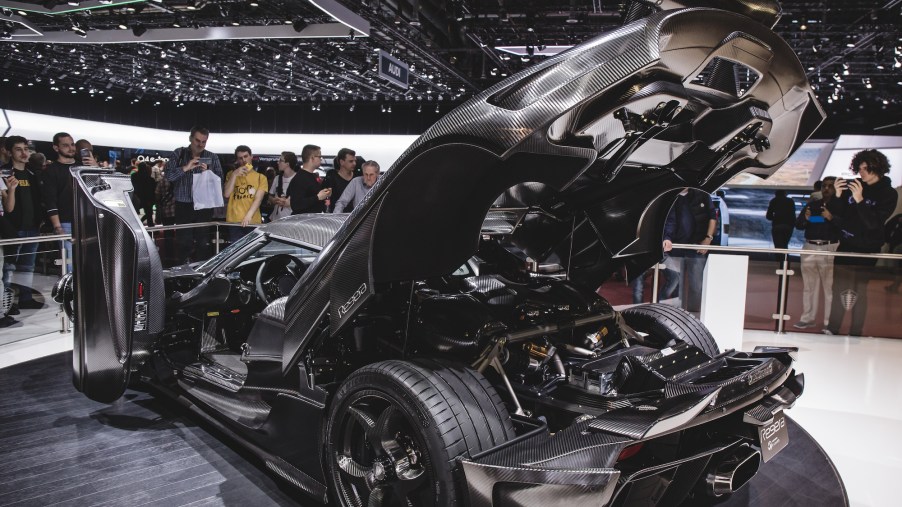
Does Hypercar Maker Koenigsegg Use Ford Engines?
Hypercars are the best of the best. These elite, ultra-high-performance vehicles set records and look stunning. So, would you be surprised to learn that one originally used a Ford engine? That’s the case with Swedish hypercar maker Koenigsegg. Here’s how its engines have evolved.
Koenigsegg’s beginnings
Koenigsegg is a relatively young automaker. It began in Sweden in 1994 when then-22-year-old Christian von Koenigsegg decided to build “the world’s greatest super-sports car,” the Koenigsegg website explains.
The first concept car, the CC, arrived in 1996. And the first production prototype, the CC8S, appeared in 2000. “CC8S” stands for “CC V8 Supercharged.” Koenigsegg built the first one in 2002 and delivered it in 2003. In all, it made only six, emphasizing a minimalist style and clean lines.
Its early hypercars
Between 2004 and 2006, Koenigsegg built the CCR. The 14 cars boasted an upgraded body and a more powerful engine than the CC8S’s. The CCR also set a speed record in 2005, reaching 387.86 km/h (241 mph) in Nardo, Italy.
The Koenigsegg CCX was another early car. It was a bit larger than the CCR but still packed a mid-engine V8. The CCX had a carbon fiber body and a removable, stowable roof. Koenigsegg designed this car to meet worldwide safety and emissions standards. It was also the brand’s first model sold in the United States.
Ford and Koenigsegg engines
Guinness World Records certified the Koenigsegg CC8S’s engine as the most powerful in a series-produced car in 2002. It made 655 hp. Koenigsegg broke its own record in 2004 with the CCR, harnessing 806 hp. But the hybrid Gemera, launched in 2020, producing an insane 1,700 hp.
Early Koenigsegg cars used the Ford Modular engine. The CC8S in 2002 packed a 4.7-liter supercharged version. Though the Swedish hypercar maker now produces its own engines, parts of them still look like Ford V8 engines, Road & Track reports.
But early engine upgrades proved challenging. Christian von Koenigsegg reinforced the block and changed the crankcase gas recirculation system, pistons, connecting rods, and camshafts. Retained from the original Ford engine were the 90-degree angle and bore spacing. Eventually, Koenigsegg made so many changes to the Ford engine that it ended up creating its own. Grainer & Worrall in the United Kingdom engineers the new blocks out of aluminum, and Koenigsegg finishes them in-house.
Among the many changes is a unique combustion chamber design. That means the engine is more efficient at producing torque, doesn’t require race fuel, and produces acceptable emissions. Despite the radical engine design, it still uses an ordinary ignition coil from NGK, which the Lexus RC F also uses.
The bore spacing and head bolt locations remain the same as those in the Ford block. So you could mount a Ford cylinder head, but it likely wouldn’t function without modifications because the new engine has higher RPMs. “One thing that appears to have stayed the same through the years is the bellhousing bolt pattern,” Road & Track reports. “If someone were able to get their hands on any of these Koenigsegg engines and controllers, they could theoretically swap them into something like a 2004-2006 Ford GT.”
The first Koenigsegg engine appeared in the CCX, and 20 to 25 percent of its parts came from the Ford motor. Today’s Koenigsegg engines include only about 5 percent Ford engine parts. The Swedish automaker also now produces multiple engines, including naturally aspirated and twin-turbocharged varieties. The Koenigsegg 5.0-liter naturally aspirated V8 engine generates 600 hp; Ford’s 5.0-liter V8 produces 480 hp. And the Ford 5.2-liter Voodoo engine found in the GT350 and GT350R generates “just” 526 hp.
Koenigsegg engines may have grown out of an American classic, but the hypercar maker has seen a huge evolution. Only a trace of the Ford engine design remains. And with hypercar prices hovering around $2 or $3 million, Car and Driver reports, these models bear no resemblance to the Blue Oval-branded vehicles.


